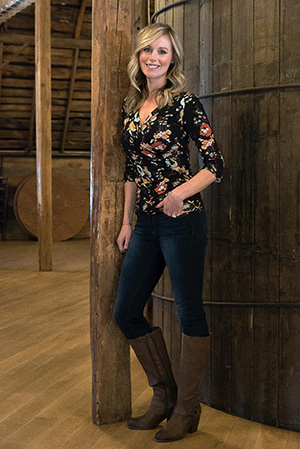| Body Positive: Embracing a Healthy Attitude Toward Food | ||||||
| by Sarah Galbraith | ||||||
|
||||||
Thinking about losing weight or getting healthier but tired of the usual methods? The turn of the year is approaching, and many of us will declare new goals in the new year for our bodies and health. Fortunately, certified eating psychology coach Melissa Story (www.melissastorycoaching.com) says it’s possible to transform your health and body without the restriction and self-hate that accompanies many strict diets. She says it’s all about women developing a new relationship with food, one that starts with loving ourselves and being present in our bodies and that achieves goals like more self-love, better nutrition, and weight loss. At a time when 91 percent of women hate their bodies, new conversations are popping up on social media, online, and in magazines and even in a recent movie. The 2016 documentary Embrace challenges the ideals that society holds for women’s bodies, from wrinkles to cellulite to weight, by talking with women around the world about self-loathing and body shaming and exclaiming “enough!” Health at Every Size is a social movement and online community based on a book of the same title that supports people of all sizes. The book, by Linda Bacon, PhD, challenges myths around weight and health, and these resources work together to form a social movement around treating bodies with respect. |
 |
|||||
With the same philosophy of body love, Story’s coaching business, called Melissa Story Coaching, aims to work with clients on issues with food, including chronic dieting, binge eating, overeating, body image, poor digestion, mood issues, and more. To explore and treat these issues with clients, she uses strategies that focus on changing attitudes and behaviors and adding in nutrient-dense food rather than restricting any foods or food groups. She was certified as an eating psychology coach by the Institute for the Psychology of Eating in Longmont, Colorado in 2013. In addition to her training, her personal background includes a disordered relationship with food, which she talks about with ease. “I’ve struggled with food,” she said on a recent afternoon, as she settled into the back of a black floral winged chair in her sunlit office on upper Main Street in Montpelier. After a series of traumatic events in her teens and without any strategies for dealing with her emotions, she turned to food to make herself feel better and to give herself a sense of control. There were cultural influences on her relationship with food and her body, too. Her friends were all on diets. “I grew up in that age of skinny, blonde, and pretty is what a woman should be,” she says. “And quiet, not big.” After several years of bulimia, she decided she wasn’t going to eat at all anymore and ended up being hospitalized for anorexia. At that time, there weren’t resources for girls and women struggling with eating disorders. But now, at 44, Story has all the resources and support she needs to find a healthy relationship with food and a positive body image, and she has chosen to make her life’s work about helping other people achieve the same thing. The theme of the work is uncovering what our bodies need for nourishment and what we’re trying to accomplish with our behaviors around food. It’s part nutrition, part psychology. “That’s basically how I work with clients, [I ask], what are you using that food for?” says Story.
One example of a strategy that many clients benefit from is simply slowing down while eating. “Across the board, people do not know how to slow down when it comes to food,” said Story. “Our culture doesn’t support that. Lunch breaks are often working breaks, or people eating in their car. People often don’t take the time to sit down with their food.” Story works with clients to change this by having them take four or five deep breaths before eating, put their utensil down between bites, breathe deeply while they chew, and check in with their hunger level while they’re still eating. “They’re getting present, getting mindful around food, and this takes a while for somebody to put into practice.” Along with these behavior changes, Story will ask clients to keep a journal while they’re eating. For example, they might write down their thoughts that come up when they sit down to a meal or when they focus on eating more slowly. “And that’s where the work is. I want to know what that thought process is, because you can’t separate mind and body, it just can’t happen.” Clients come to Story for weight loss and improved body image and to simply be more comfortable in their body. Another top priority is getting over the diet mentality. “With a huge number of my clients, I feel like I de-program them from the Weight Watchers mentality,” she says. “They’re learning to see food as food, not as numbers or points, or something good or bad.” “It’s amazing the number of people who aren’t getting pleasure out of eating anymore because they can only see it this one certain way, and they’ll spend all their points on a piece of cheesecake and then starve for the rest of the day. That’s not nutrition, it’s not a way of life at all,” says Story. Story works with clients to bring the pleasure back to eating, even if it means a hot fudge sundae, piece of cheesecake, or can of soda. Instead of restricting, Story helps her clients to focus on adding healthy foods. By adding an apple and a salad, for example, they can begin to notice how those foods make them feel more full than other processed or sugary options. And these behavior changes lead to better nutrition and weight loss.
Story meets clients where they currently are with food and nutrition, and she emphasizes that it’s a judgment-free zone: “When I do somebody’s dietary intake [in the first appointment], I have to be careful not to be judging their diet.” For example, if a client is eating a nutritionally poor diet, she works with them in a slow way to make changes, starting with education around nutrition. “I say, ‘If you want to keep eating these things, that’s fine, but we’ve got to add in some nutrition too.’” More often than not, clients begin to see how whole foods that are more nutritious also make them feel better in their bodies by providing more stable energy and keeping them satisfied and full longer.
Another opportunity for mind-body connection is exercise, which Story sees as a supplement to good nutrition and mindful eating. If a client is not active at all, she works to incorporate a form of exercise the client enjoys, as long as the client is physically cleared to do the exercise by his or her physician. “Exercise has got to be enjoyable; it’s got to be something they can sustain,” she said. For example, if a client loves to dance, but isn’t yet ready to try a dance class, she tells the client to dance around the living room. “[Do it] until you break a sweat three or four times a week,” she recommends. Whatever the exercise is, Story says the greatest benefit is achieved by clients being present in the body, just as she recommends they do with eating. “[It’s all about] using your body, feeling it, appreciating it, giving it gratitude. Each time we can do that it helps us transform.”
|
||||||
|
Sarah Galbraith is a writer covering outdoor sports, adventure, local food, and craft beer. Follow her on Twitter @adventurevt. |
|||||


